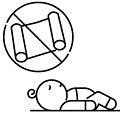It's common for newborns to hiccup, sneeze, cross their eyes, and sound congested. But tell your doctor if there's a yellow tint to your baby's skin or eyes (jaundice). Expect at least 6 wet diapers and 3 stools a day. Stools should be yellow and watery, not dark green and sticky.

Every 24 hours, breastfeed at least 8 times or formula-feed at least 6 times. To wake your baby for feeding, change their diaper or gently tickle their back.

Be sure all visitors are up to date on vaccines. Ask visitors to wash their hands. And never let anyone smoke around your baby.

Feeding your baby
- If you breastfeed, offer both breasts to your baby at each feeding. Switch which breast you start with each time.
- If you formula-feed, ask your doctor how much formula to give your baby.
- Don't warm bottles in the microwave. Check the temperature by placing a few drops on your wrist.

Keeping your baby safe
- Always use a rear-facing car seat. Learn how to install it in the back seat.
- Use hats and clothing to protect your baby from the sun.
- Never shake or spank your baby.
- Learn how to take your baby's rectal temperature if they're sick. Call your doctor with any questions.

Keeping your baby safe while they sleep
- Always put your baby to sleep on their back.
- Don't put sleep positioners, bumper pads, loose bedding, or stuffed animals in the crib.
- Don't sleep with your baby. This includes in your bed or on a couch or chair.
- Have your baby sleep in the same room as you for at least the first 6 months.
- Don't place your baby in a car seat, sling, swing, bouncer, or stroller to sleep.

Caring for yourself
- Trust yourself. If something doesn't feel right with your body, tell your doctor right away.
- Sleep when your baby sleeps, drink plenty of water, and ask for help if you need it.
- Tell your doctor if you or your partner feels sad or anxious for more than 2 weeks.
How to get your baby latched on well

First, make sure your baby's face and chest are facing your breast. Support your breast with your fingers under your breast and your thumb on top.

Then, gently touch the middle of your baby's lower lip. When your baby's mouth opens wide, quickly bring your baby to your breast.
Follow-up care is a key part of your child's treatment and safety. Be sure to make and go to all appointments, and call your doctor if your child is having problems. It's also a good idea to know your child's test results and keep a list of the medicines your child takes.
Where can you learn more?
Go to http://www.healthwise.net/patientEd
Enter Y638 in the search box to learn more about "Child's Well Visit, 1 Week: Care Instructions".
Current as of: October 24, 2023
Author: Healthwise Staff
Clinical Review Board
All Healthwise education is reviewed by a team that includes physicians, nurses, advanced practitioners, registered dieticians, and other healthcare professionals.

